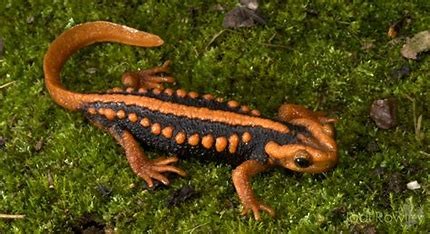Description

Disclaimer: Copyright infringement not intended.
Context
- Recently, a team of scientists recorded a new species of salamander— the Tylototriton zaimeng in the Zaimeng Lake of Manipur.
Details
- A group of researchers embarked on an expedition to the Khongtheng mountain range with the aim of unraveling the traits of Tylototriton verrucosus, which is colloquially referred to as the crocodile newt.
- They recorded a new species of salamander — the Tylototriton zaimeng — in the Zaimeng Lake within the Koubru Forest Division in Kangpokpi district, one of the worst-hit by the ethnic violence.
- Zaimeng in the Liangmai Naga dialect means “puzzle” or “mystery”.
Tylototriton zaimeng
- Tylototriton zaimeng, commonly known as the Zaimeng newt, is a species of newt that belongs to the family Salamandridae.
- This species is native to China and is primarily found in the Guizhou and Yunnan provinces.
- Phylogenetic analysis revealed that the new salamander is a sister species of the T. panwaensis and T. houi found in northern Myanmar and southern China,
- zaimeng was found to be a medium-sized salamander.
- Its head is massive and wide, with a rounded snout and protruding supratemporal bony ridges
- A wide and unsegmented vertebral ridge ran along its back, accompanied by 13-14 pairs of rib nodules, marking a clear distinction from its kin.
- The salamander exhibited a captivating brown hue, adorned with subdued orange to yellowish-brown markings on its head, vertebral ridge, rib nodules, palms, soles, vent, and ventral tail ridge. Notably, its distinctiveness was accentuated by its vomerine teeth, which were elegantly arranged in two distinctly curved, bell-shaped series.
Zaimeng Lake
- Zaimeng in the Liangmai Naga dialect means “puzzle” or “mystery”.
- It is situated on top of Khongtheng mountain ranges.
- The majority of the lake is primarily composed of a marshy expanse featuring dense grass-like weeds, interspersed with reeds and verdant mosses.
.jpg)
Conclusion
The scientists strongly recommended adding the newfound salamander species to the International Union for Conservation of Nature (IUCN) Red List under the vulnerable category. Their emphasis on the urgency of conservation endeavors aimed at safeguarding both the species itself and its delicate habitat was a key point of their advocacy.
|
PRACTICE QUESTION
Q. With reference to India’s Biodiversity “Tylototriton zaimeng” is:
(a)Birds
(b)Primates
(c)Reptiles
(d)Amphibians
|
https://www.thehindu.com/sci-tech/science/scientists-solve-manipur-salamander-puzzle/article67198322.ece












